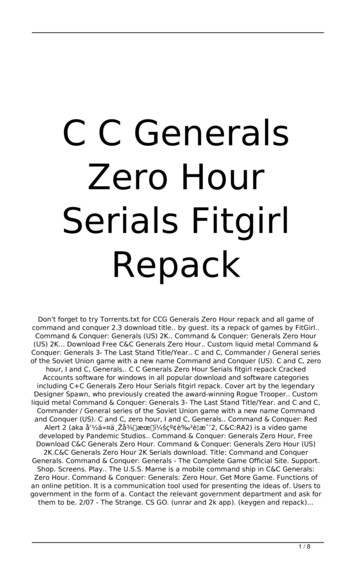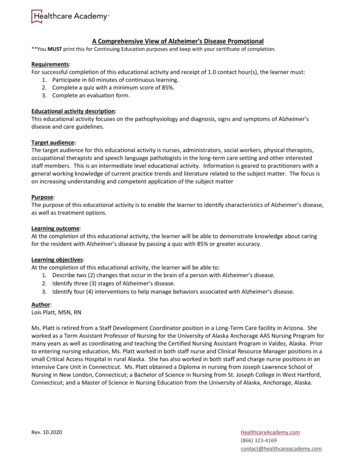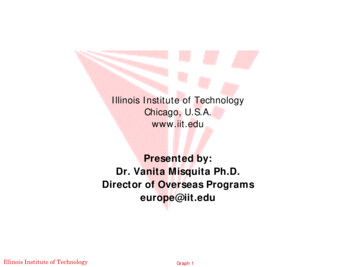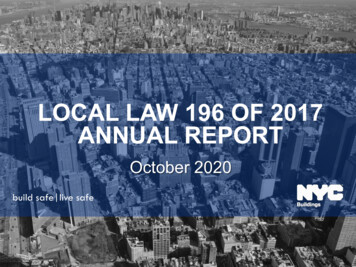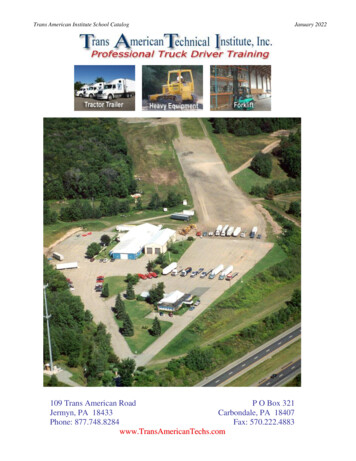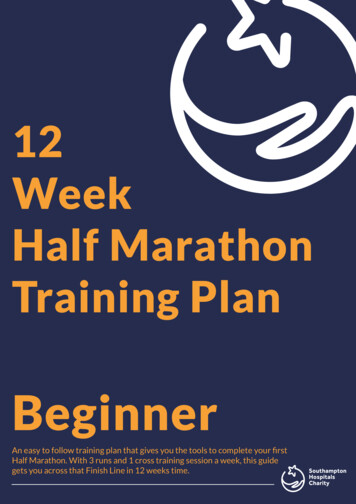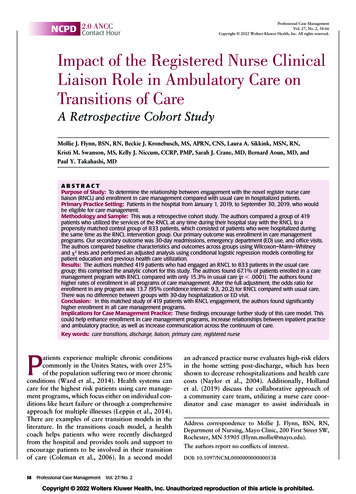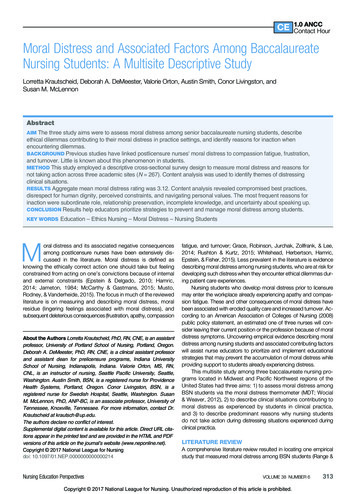
Transcription
1.0 ANCCContact HourNLN Core Competencies for Nurse Educators: Are They Presentin the Course Descriptions of Academic Nurse EducatorPrograms?Ann Fitzgerald, Angela M. McNelis, and Diane M. BillingsAbstractAIM As an initial approach to determining representation of the NLN Core Competencies for Nurse Educators inMaster’s of Science in Nursing Education and Post-Master’s Certificate programs, the study identified the presence ofthe competencies in course descriptions.BACKGROUND The competencies are the gold standard to ensure academic nurse educators have the knowledgeand skill to teach, assist learners, develop curricula, and implement effective evaluation methods.METHOD A descriptive design that applied web scraping techniques was used to collect data from school web pages,including course descriptions, credit hours, practica information, distance accessibility, and Certified Nurse Educatorexam preparation.RESULTS Four competencies were well represented ( 85 percent), and four competencies were poorly represented( 50 percent) in a sample of 529 schools.CONCLUSION Programs should review courses and course descriptions for inclusion of all competency areas thatprepare nurse educators and make revisions to address poorly represented competencies.KEY WORDS Academic Nurse Educator – Academic Programs – Certified Nurse Educator – Course Descriptions –Master’s Nurse Educator – NLN Core Competencies – Post-Master’s Nurse EducatorNurse educators entering academe frequently struggle with therole, as most are clinicians coming from advanced practice orare graduates from DNP or PhD programs without educationcourses (Goodrich, 2014; Ortelli, 2012; Poindexter, 2013). Essentialskills for nurse educators, such as facilitating learning, assisting novicelearners, developing curricula, and implementing effective evaluationmethods, are typically lacking even in expert clinicians (Christensen,2015; Goodrich, 2014; Halstead, 2012; Poindexter, 2013). Becauseacademic nurse educators teach in both classroom and clinical settings, they are bound to professional standards set forth by peersfrom both nursing and nursing education (Frank, 2015). To more specifically define the role of the academic nurse educator, the NationalLeague for Nursing (NLN) established a task force to review the literature and identify essential competencies that comprised the role(NLN, 2002). The work of the task force was published by the NLNas Core Competencies of Nurse Educators With Task StatementsAbout the Authors Ann Fitzgerald, PhD, RN, CNE, FNP-BC, is anurse practitioner, Extended Care Specialists, Fort Wayne, Indiana.Angela M. McNelis, PhD, RN, FAAN, ANEF, CNE, is professor andassociate dean for scholarship, innovation and clinical science,George Washington University School of Nursing, Washington, DC.Diane M. Billings, EdD, RN, FAAN, ANEF, is professor emeritus,Indiana University, Indianapolis, and consultant in nursing education.For more information, contact Dr. Fitzgerald at ancillanurse@yahoo.com.The authors have declares no conflict of interest.Copyright 2019 National League for Nursingdoi: 10.1097/01.NEP.00000000000005304 January/February 2020in 2005 and reaffirmed in 2012 (NLN, Certification Commission, &Certification Test Development Committee [NLN, Cert. Comm.]). Thisinaugural work was critical to guide the preparation and ongoing development of this specialty area of nursing.While the NLN Core Competencies describe the scope of educator practice, they also serve as an evidence-based framework forcurricular design in programs that prepare nurse educators (Halstead,2007). Moreover, the NLN Core Competencies were used to guidethe development of a certification exam for nurse educators —the Certified Nurse Educator (CNE) exam (Byrne & Welch, 2016;Christensen, 2015; Lundeen, 2014; NLN, 2005; Ortelli, 2012, 2016).Since the publication of the NLN Core Competencies, several studieshave used the NLN Core Competency framework to examine therelationship between academic preparation and pass rates on theCNE exam (Byrne & Welch, 2016; Christensen, 2015; Lundeen,2014; Ortelli, 2012, 2016), to assess student and educator competency (Kalb, 2008), and to measure progress from entry to graduation of students in a master’s degree nurse educator preparationprogram (Kalb & Skay, 2016). The evolution and application of theNLN Core Competencies are important to validating and standardizing the nurse educator role. Yet, no study has examined the presence of the NLN Core Competencies in curricula of programs thatprepare nurse educators.Even though the NLN Core Competencies are the only guide foracademic nurse educators and were delineated to guide both thepreparation and the practice of nurse educators (NLN, 2005; NLN,Cert. Comm., 2012), little evidence was found that showed the consistent presence of these competencies in curricula that preparenurse educators. The purpose of this study was to determine thewww.neponline.netCopyright 2019 National League for Nursing. Unauthorized reproduction of this article is prohibited.
NLN Core Competencies in Nurse Educator Program Course Descriptionsextent to which the NLN Core Competencies for Nurse Educatorswere included in the course descriptions of master’s of nursing programs with an education focus (MSN Ed) or post-master’s certificateprograms with a nursing education focus (PMC). The determinationwas based on a review of key words pertaining to the Core Competencies in course descriptions and other documents available on thewebsites of all schools of nursing in the United States. During thestudy, additional information was collected to provide background regarding the current context of the specified graduate programsacross the United States. Data included credit hours for the entireprogram and education focus area, credit hours for the practicum,courses used outside of nursing, distance accessibility, geographicdistribution of the programs, and whether the program stated it prepared graduates to take the CNE exam. These data are also reportedto provide a description of the current structure of these programs inthe United States.the number of credit hours in the educational focus area to meet expected outcomes for MSN Ed programs. Ruland and Leuner (2010)acknowledged the challenge to include MSN core courses, alongwith the required clinically focused courses, while including coursesthat prepare nurse educators and yet keep the credit hours manageable. In their study of 198 programs, the authors found courses inthe education focus area included content in teaching strategies/instructional design (97 percent), curriculum development (96 percent),a teaching practicum (92 percent), and evaluation methods (89 percent). Courses in a clinical specialty area, such as geriatrics, pediatrics, or adult health, were required in 46 percent of the programsreviewed, and of those programs, 75 percent of the clinical specialtycourses were designed for the nurse educator role (Ruland & Leuner,2010). These researchers concluded that a call for discussion and reconfiguration of the curriculum to evidence-based standards for themaster’s-prepared nurse educator was needed.BACKGROUNDCertification as a Nurse EducatorNurse educators should have the requisite knowledge and skillsas identified by the NLN Core Competencies (NLN, 2005; NLN, Cert.Comm., 2012) to fulfill their role. These competencies define the nurseeducator role and specialized preparation and are considered a goldstandard (Higbie, 2010; NLN, Cert. Comm., 2012; Ortelli, 2012).Current literature, however, does not provide evidence that theNLN Core Competencies have been integrated into curricula ofacademic nurse educator or nurse educator certification programsacross the United States. Without the NLN Core Competenciesas a guiding and standardizing curricular framework, graduatesof these programs are at risk for being unprepared to fulfill the nurseeducator role to the fullest extent possible or become certified as anurse educator (Christensen, 2015; Goodrich, 2014; Halstead, 2012;Poindexter, 2013).In the 2012 revision of The Scope of Practice for Academic Nurse Educators (NLN, Cert. Comm., 2012), a nurse educator practice analysis was used to update the CNE test blueprint. The update providedassurance that the NLN Core Competencies remained aligned withstandards of practice and standards of professional developmentfor nursing designated by the American Nurses Association (NLN,2010). Achievement of the CNE designation continues to supportproficiency as an advanced practice role and provides validation ofknowledge, personal accomplishment, and satisfaction (Barbé &Kimble, 2018).The few studies that have been conducted to examine hownurse educators achieve the CNE credential are predominantly descriptive in nature and suggest that academic programs may notcontain the necessary content to prepare nurse educators for theirfull role (Byrne & Welch, 2016; Christensen, 2015; Lundeen, 2014;Ortelli, 2012, 2016). Moreover, these studies also supported theNLN Core Competencies as an evidence-based framework to guidecurricula that prepare faculty for the teaching aspect of their role andto become a CNE. Although the evidence is scant, it consistentlysupports the utility of the NLN Core Competencies in directing educational efforts. Therefore, this study, to determine the presence ofsaid competencies, is necessary and foundational in moving thescience forward.The NLN Core Competencies for Nurse EducatorsIn 2002, the NLN appointed a task group of nursing educationleaders to define how nursing faculty should be properly preparedto teach (NLN, 2002). Through a comprehensive and rigorous process of literature review and analysis, the NLN published the NurseEducator Competencies: Creating an Evidence-Based Practice forNurse Educators (Halstead, 2007). The NLN Core Competenciesfor Nurse Educators are to: (1) facilitate learning, (2) facilitate learnerdevelopment and socialization, (3) use assessment and evaluationstrategies, (4) participate in curriculum design and evaluation of program outcomes, (5) function as a change agent and leader, (6) pursue continuous quality improvement in the nurse educator role, (7)engage in scholarship, and (8) function within the educational environment (NLN, 2005; NLN, Cert. Comm., 2012). Collectively, theNLN Core Competencies are considered the standard of practicefor nurse educators and the guide for preparing nurses for the roleof academic nurse educator (Higbie, 2010; NLN, Cert. Comm.,2012; Ortelli, 2012).Educator Preparation in Master’s in Nursing DegreeProgramsMaster’s degree programs in nursing education vary significantly inthe credit hours, structure, and ways in which the focus area fitswithin the MSN program. Faculty must balance tradeoffs betweenthe MSN core courses, the three recommended clinical courses(pharmacology, pathophysiology, and physical assessment), andNursing Education PerspectivesMETHODDesign and Data CollectionA descriptive design using a web scraping technique served to collect study data. Inclusion criteria for this study were US MSN Ed orPMC programs accredited by the American Association of Collegesof Nursing (AACN, 2015) or the Accreditation Commission forEducation in Nursing (ACEN, 2015). Exclusion criteria were programsreported to prepare staff nurse educators only, school nurse educators (K-12), or health educators. In addition, programs with missing,incomplete, or incorrect data, such as mismatched course title/description, were excluded. Inaccessible websites or those that didnot provide complete information about the focus area were alsoexcluded from collection of data.Based on lists available in October 2015, websites of 576 MSNEd and PMC programs were reviewed to ascertain the courses required for completion of the focus area or certificate in nursing education offered by each school. Because course descriptions shouldVOLUME 41 NUMBER 1Copyright 2019 National League for Nursing. Unauthorized reproduction of this article is prohibited.5
Fitzgerald et alinclude information about the concepts and content included in thecourse, the descriptions for the courses required for the MSN Edspecialty or PMC focus were reviewed and included in the study.Course descriptions not easily found on the school of nursingwebsite were located, where possible, using the course requirements listed for the degree and focus area in the course catalog.Of the 576 programs reviewed, 529 programs met inclusioncriteria and were included in this study. Data retrieved from thewebsites included course descriptions, number of credit hours percourse and any laboratory or practicum time required, distance accessibility, and if the program stated it prepared graduates to takethe CNE exam. Each course description was thoroughly examinedto determine which key words from the definition of the NLN CoreCompetencies were addressed. For purposes of this study, competency representation of 85 percent or greater was defined as “wellrepresented,” while competency representation at or below 50 percent was defined as “poorly represented.” The institutional reviewboard determined the study was exempt.Data Reliability and AnalysisTo support reliability of data interpretation (O’Rourke & Zerwic, 2016;Wyman & Henly, 2015), including identifying presence of educatorcompetencies in course descriptions, eight nursing education experts corroborated the primary investigator’s data interpretationusing an iterative process. Differences in interpretation were discussed, and revisions were made prior to the next iteration and continued until confidence in interrater reliability was reached. Usingthis multiphased, iterative process, strong ( 80 percent) agreementwas established prior to the primary investigator collecting studydata. IBM SPSS Statistics 24 was used to conduct descriptiveanalyses.RESULTSDemographic FindingsAt the time of the study, the AACN listed 484 schools offering master’s or postmaster’s programs in nursing, and the ACEN listed 92schools. Of the 576 total, the final sample size for the study was529 schools (92 percent) and included 317 (60 percent) programswith MSN Ed programs and 212 (40 percent) with PMC programs.Schools that offered both the MSN Ed and PMC programs totaled174, while 143 schools offered MSN Ed only and 38 schools offeredPMC only.Total credit hours in MSN Ed programs ranged from 28 to 65with a mean of 39 (SD 5.3); nursing education focus area credithours ranged from 6 to 47 with a mean of 19 (SD 7.5). The PMCprogram credit hours ranged from 3 to 45 with a mean of 15(SD 5.2). The majority of both programs (89 percent) required apracticum course. Almost all practicum hours were reported as credithours; however, a few practicum courses were reported as clockhours, precluding a consistent method of reporting the actual number of hours of the experience. Nursing education practica credithours ranged from 1 to 18 for MSN Ed programs and 1 to 14 forPMC programs. Mean practicum credit hours were 4.4 for MSN Ed(SD 2.2) and 4.6 for PMC programs (SD 1.9). A total of 23 programs used clock hours when reporting practica requirements forboth MSN Ed and PMC programs; clock hours ranged from 60 to500 with a mean of 186 hours (SD 101.6).Forty-two (13 percent) MSN Ed programs used courses fromschools outside nursing to fulfill or complement program requirements. Courses in the school of education were used most frequently(n 25); additional courses were from an education subspecialty orother departments, such as statistics, biology, or ethics. Notably,every state in the United States, except Hawaii, offered either anMSN Ed or PMC. Of the 529 MSN Ed and PMC programs, 199Figure 1. Percent of competencies found in MSN education program course descriptions.6 January/February 2020www.neponline.netCopyright 2019 National League for Nursing. Unauthorized reproduction of this article is prohibited.
NLN Core Competencies in Nurse Educator Program Course DescriptionsFigure 2. Percent of competencies found in post-Master's certificate program course descriptions.(37 percent) were completely distance accessible. Only 317 (32 percent) of the MSN Ed program and 212 (38 percent) of PMC programwebsites clearly stated the program prepared graduates to take theCNE exam.Representation of NLN Core Competencies CourseDescriptionsFigure 1 shows the extent to which descriptions for courses in theMSN Ed programs included statements indicating the presence ofthe NLN Core Competencies; Figure 2 contains the same informationfor the PMC programs. For both programs, the first four competencies are well represented ( 85 percent); however, the final four competencies are poorly represented ( 50 percent).DISCUSSIONPresence of the NLN Core CompetenciesAs noted in Figures 1 and 2, only four of the NLN Core Competencies(facilitate learning, participate in curriculum design and program evaluation, use assessment and evaluation strategies, and pursue continuousquality improvement in the nurse educator role) were well represented incourse descriptions. Notably, the first three NLN Core Competencieslisted above all had greater than 90 percent presence and are expectededucator skills recommended by the AACN (2011) Master’s Essentials,the Institute of Medicine (IOM, 2011) report, and Benner, Sutphen,Leonard, and Day (2010). Moreover, they were the most common content areas noted in Ruland and Luener’s (2010) study and in the study ofstudent self-report of competency attainment by Kalb and Skay(2016).In this study, the NLN Core Competency pursue continuousquality improvement in the nurse educator role was found in MSNEd and PMC course descriptions (fourth highest percentage in both).The content supporting this NLN Core Competency frequently wasNursing Education Perspectivesprovided within several courses, rather than being identified with a specific course. Because this subject area appeared in multiple course descriptions, this competency was well represented in the curricula of theMSN Ed and PMC programs. In addition, faculty development, whichenhances the role of the nurse educator, was recommended byBenner et al. (2010) and the IOM (2011). Quality improvement in therole of a nurse educator promotes continuous education for all whoteach. Encouraging faculty development in all aspects of the nursefaculty role will perpetuate growth in nursing education.Interestingly, the facilitate learner development and socializationcompetency was not well represented in MSN Ed or PMC programsin this study. Despite its linkage to the NLN Core Competency of facilitate learning, the focus of facilitate learner development and socialization is on the ability of the nurse educator to adapt teaching to studentneeds and diversity, to assist students to learn how to learn, and to socialize them to the professional nursing role. Lack of representation may bedue to the difficulty to enact in a classroom setting, and thus, the keywords did not appear in didactic course descriptions.The NLN Core Competencies of engage in scholarship, functionas a change agent and leader, and function within the educationalenvironment were found in less than half of the MSN Ed or PMC programs, even though these skills are identified as critical by the AACN(2011) Master’s Essentials, the IOM (2011), and Benner et al. (2010).Where possible, the content associated with these competencieswas integrated into the overall MSN program courses; it was not emphasized in the education focus area courses.Engage in scholarship focuses on understanding and using evidencebased teaching practices or engaging in the scholarship of teaching andwas also poorly represented. Few programs were found that requiredboth production and use of scholarly work, even though creating andusing research was listed as an essential function by the IOM in 2011and Quality and Safety Education for Nurses (QSEN) in 2012.VOLUME 41 NUMBER 1Copyright 2019 National League for Nursing. Unauthorized reproduction of this article is prohibited.7
Fitzgerald et alMost nurse educators are prepared at the master’s level and are expected to take on leadership roles in academic institutions, yet the keywords that pertain to function as a change agent and leader were notwell represented in course descriptions in these programs. Althoughthese skills are identified as critical by the AACN (2011) Master’s Essentials, the IOM (2011), Benner et al. (2010), and NLN (2010) Outcomesand Competencies for Nursing Graduates, they were inadequately represented in MSN Ed courses and even more poorly represented in PMCcourses. Because these role skills are also components of an MSN program, it is possible that the content and experiences needed to acquire these competencies are included elsewhere in the overallMSN program.Key words related to function within the educational environmentwere difficult to locate in course descriptions and found to have thelowest percentage in both PMC and MSN Ed programs. Despitethe IOM (2011) and QSEN (2012) reports indicating these skills werenecessary at the graduate level, very few programs indicated ways toprovide student interaction supporting this competency. It may bethat this content was included in the practica; however, practicacourse descriptions were particularly scant across all programs.and a focus on preparation for the CNE exam was missing on mostprogram websites. Without explicit documentation of the presence of theNLN Core Competencies and acknowledgement that programs preparegraduates to sit for the CNE exam, potential nurse educators are at a disadvantage when choosing their academic program. Moreover, if, in fact, thiscritical content is not included in programs, graduates may lack preparationfor the academic nurse educator role.LIMITATIONSThe study is limited by the completeness of the lists obtained from theAACN (2015) and ACEN (2015) websites. Limitations related to datacollection include websites that were inaccessible or under constructionand issues with program information such as missing or inconsistentdata. Reliance on course descriptions to determine the presence ofthe competencies also limited the study because universities often haveword restrictions for descriptions and may not be inclusive of all learningoutcomes for the course. This was particularly an issue for understanding the inclusion of the competencies in practicum courses. Finally,only one investigator collected data and could have introduced biaswhen determining presence of the NLN Core Competencies.Credits and Practica HoursRECOMMENDATIONSThe number of credits required for MSN Ed and PMC programs varied significantly in this sample of schools. This may be because MSNprogram accreditation standards are not prescriptive, and there is noreported evidence for the number of credit, clinical, practicum, clock,or laboratory hours necessary to achieve program outcomes. Furthermore, there is no evidence on which to base decisions aboutthe ratio of core MSN courses and courses in a specialty area.Most programs listed a practicum requirement and included the totalnumber of credit or clock hours associated with the practicum; however, few described practicum goals or included sufficient information in the course description to identify content that contributes toattaining the NLN Core Competencies. In addition, nursing organizations that accredit MSN programs have not specified the number ofpractica hours required for nurse educator practice in the same waythat organizations have prescribed the hours for nurse practitionersand other specialty practice areas (AACN, 2013; ACEN, 2013;American Nurses Credentialing Center, 2016; National Organizationof Nurse Practitioner Faculties, 2009). Currently, eligibility requirements to take the CNE exam include completion of courses withan educator emphasis or two years of experience in an academicsetting, thus giving value to both education and experience but notrequirements about practica hours (NLN, 2017).Despite the limitations of this study, there are practical recommendations that can be implemented to ensure clear representation of theNLN Core Competencies in course descriptions and on program websites. Several recommendations are also offered for future research.Preparation for CertificationApproximately one third of the programs indicated the nurse educatorcurriculum prepared graduates for the CNE exam. Acknowledging thepreparation for the CNE exam indicates that the program prepares graduates to attain competencies in all aspects of the faculty role and are prepared to become certified, as is the case for other specialty practiceareas (Advanced Practice Registered Nurse [APRN] Consensus WorkGroup & the National Council of State Boards of Nursing APRNAdvisory Committee, 2008). Schools should identify that their programsprepare students to take the exam to validate the advanced practice expertise accomplished by nurse faculty (Cannon & Boswell, 2016).In summary, there was great variability in the NLN Core Competencies represented in the course descriptions. In addition, the number of credits to achieve the MSN Ed and PMC varied significantly,8 January/February 20201. Faculty offing MSN Ed and PMC programs should carefully review and revise practica and course descriptions, if warranted,to indicate which of the NLN Core Competencies are includedin the course.2. Credit and practica hours in the MSN Ed and PMC programsvaried widely in this study, and there is no evidence on whichto base recommendations for the number and type of creditsto attain the NLN Core Competencies. Future studies areneeded to determine the appropriate number of credit orclock hours required to achieve integration of all eight competencies and if schools of nursing with increased credit/clockhours had better representation of the competencies.3. Because this study revealed a wide range of hours for thepractica and a variation in how credit hours were reported,faculty should clearly describe in the practica course description how many clock hours are represented by credit hours.4. Schools of nursing should update their websites frequently tomaintain accuracy of course descriptions and credit hour allocation, especially during program or curricular changes. Websitesshould be user friendly and easy to navigate.5. Given the inherent limitations of web scraping, other methodsof identifying the presence of the NLN Core Competencies inMSN Ed and PMC courses should be used. For example,reviewing syllabi containing course and student learning outcomes could further pinpoint inclusion of the competenciesand elucidate gaps. In addition, determination of specificlearning activities and outcomes, noted in practicum coursesyllabi, may provide additional evidence of the inclusion ofthe NLN Core Competencies in the curriculum.CONCLUSIONThis study identified the presence of the NLN Core Competencies incourse descriptions required by MSN Ed and PMC programs in nursing education. Results showed only half of the competencies werewww.neponline.netCopyright 2019 National League for Nursing. Unauthorized reproduction of this article is prohibited.
NLN Core Competencies in Nurse Educator Program Course Descriptionswell represented and wide variation in required credit and practicahours. In addition, programs often did not indicate that the programprepared graduates for the CNE exam. Recommendations noted inthis study may be used to guide future research, including the extentto which the competencies are integrated in the curricula and howmany credit and practica hours are needed to prepare competentnurse educators.REFERENCESAccreditation Commission for Education in Nursing. (2013). Accreditation manual.Retrieved from on Commission for Education in Nursing. (2015). Search ACEN accreditednursing programs. Retrieved from .htmAdvanced Practice Registered Nurse (APRN) Consensus Work Group & theNational Council of State Boards of Nursing APRN Advisory Committee.(2008, July 7). Consensus model for APRN regulation: Licensure, accreditation,certification & education. Retrieved from www.nacns.org/docs/APRN-Report080707.pdfAmerican Association of Colleges of Nursing. (2011). The essentials of master’seducation in nursing. Retrieved from www.aacn.nche.eduAmerican Association of Colleges of Nursing. (2013). Competencies and curricularexpectations for clinical nurse leader education and practice. Retrieved 3.pdfAmerican Association of Colleges of Nursing. (2015). Commission on CollegiateNursing Education. Retrieved from www.aacn.nche.eduAmerican Nurses Credentialing Center. (2016). ANCC Certification Center. Retrieved from rbé, T., & Kimble, L. P. (2018). What is the value of nurse educator certification? Acomparison study of certified and noncertified nurse educators. Nursing Education Perspectives, 39(2), 66-71. doi:10.1097/01.NEP.0000000000000261Benner, P., Sutphen, M., Leonard, V., & Day, L. (2010). Educating nurses: A call forradical transformation. San Francisco, CA: Jossey-Bass.Byrne, M. M., & Welch, S. (2016). CNE certification drive and exam results. NursingEducation Perspectives, 37(4), 221-223.Cannon, S., & Boswell, C. (2016). Evidence-based teaching in nursing: A foundationfor educators (2nd ed.). Retrieved from www.r2library.comChristensen, L. S. (2015). Factors related to success on the Certified Nurse Educator(CNE) examination (Doctoral dissertation). Retrieved from ProQuest Dissertations and Theses database (UMI No. 3708579).Frank, B. (2015). The process of becoming a nurse educator. In M. H. Oermann (Ed.),Teaching in nursing and role of the educator: The complete guide to best practicein teaching, evaluation, and curriculum development (pp. 1-14). New York,NY: Springer.Goodrich, R.
ence of the NLN Core Competencies in curricula of programs that prepare nurse educators. Even though the NLN Core Competencies are the only guide for academic nurse educators and were delineated to guide both the preparation and the practice of nurse educators (NLN, 2005; NLN, Cert. Comm., 2012), little evidence was found that showed the con-

